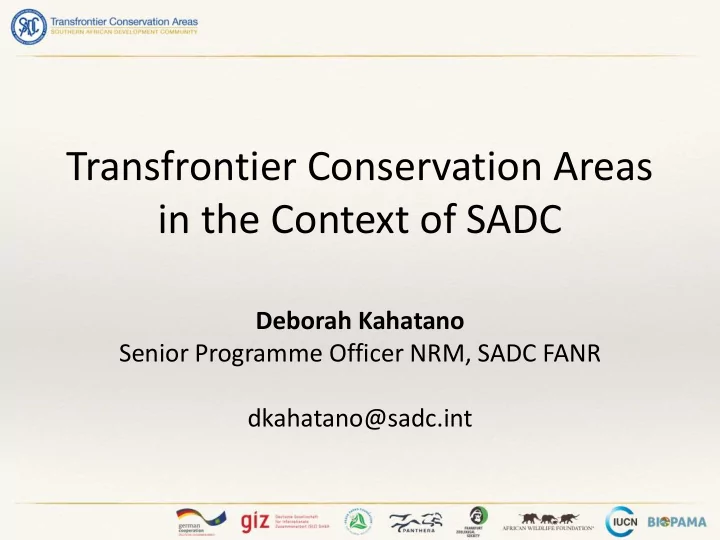

Transfrontier Conservation Areas in the Context of SADC Deborah Kahatano Senior Programme Officer NRM, SADC FANR dkahatano@sadc.int
Relevance of Natural Resources for SADC • Southern Africa is endowed with abundant natural resources, including wild animals, forests, fish and marine life • >50% of the GDP in the Member States is primarily earned from agriculture, mining, forestry, tourism and wildlife sectors • Most rural communities directly depend on natural resources for their livelihoods • The region attracts millions of tourists every year, providing direct and indirect income opportunities for many people (10 tourists create one job)
Threats to Natural Resources Base Illegal logging Uncontrolled fires Poaching and illicit wildlife trade Pollution Invasive alien species Habitat loss/change, e.g. agricultural expansion
Increasing habitat fragmentation. Increasing pressures on protected areas. How can ecological connectivity between ecosystems be sustained?
Transfrontier Conservation Area (TFCA) is defined as: “an area or component of a large ecological region that straddles the boundaries of two or more countries, encompassing one or more protected areas as well as multiple resource use areas” One major objective of SADC TFCAs is to foster international collaboration and cooperation between the Parties in order to facilitate effective management of transboundary ecosystems Harmonization of policies, strategies and practices for managing natural resources along international boundaries of the Member States”
TFCAs: A paradigm shift for SADC 1. Connectivity matters : landscape approach 2. Think regional : TFCAs are multi-stakeholder entities that rely on cooperative management 3. Conservation without people is just conversation : TFCAs are local development hubs that create income and benefits to local communities through conservation friendly local economies and tourism TFCA = BIODIVERSITY + DEVELOPMENT
TFCA initiatives are ecologically defined geographic spaces. They are largely driven What are TFCAs? by the environment & tourism ministries /Ai-/Ais-Richtersveld Transfrontier Park (TFP): 2 countries, adjacent Kavango Zambezi (KAZA TFCA): 5 countries, national parks (one land multiple land use types (villages, communal land, use system), relatively national parks, reserves, private land …), 520 000 small km2 = larger than Spain, almost size of Kenya
Enabling Regional Frameworks • Regional Indicative Strategic Development Plan (RISDP, 2015): Sustainable transboundary NR management identified as key for sustainable regional development and regional integration • SADC Protocol on Wildlife Conservation and Law Enforcement of 1999: “to promote the conservation of shared wildlife resources through the establishment of TFCAs” (Article 4,2(f)) • SADC Protocol on Fisheries (2001) • SADC Protocol on Forestry (2002) • SADC Protocol on Development of Tourism (2002) • SADC Protocol on Shared Water Courses (2015) • Strategy papers such as the Regional Biodiversity Strategy (2006) and the Regional Forestry Strategy (2010), SADC Law Enforcement and Anti-Poaching Strategy (2015) • SADC TFCA Programme of 2013
Benefits of TFCAs for the SADC Region: – TFCA are testing grounds/ incubators for regional integration agenda through policy harmonisation, joint management tools, joint governance structures, etc. – TFCAs play a critical role in the conservation and management of transboundary ecosystems – TFCAs contribute to the expansion of the Conservation Estate through the extension of a network of well- managed conservation areas – TFCAs serve as nodes for rural development through conservation friendly land use activities, e.g. ecotourism, conservation agriculture, game ranching – TFCAs offer unique cross-border experiences and are therefore an ideal platform for promoting tourism growth in the region
Success Factors • The success of TFCAs relies on: Effective cross-border cooperation between countries Engagement & participation of communities in TFCA processes In country, cross sectoral cooperation (e.g. customs, agriculture, rural development, tourism, wildlife protection) Improved cooperation with stakeholders (local government, NGOs, Private sector, ICPs) • Strategic partnerships are critical to close funding & capacity gaps, create ownership at the local level & help to deliver the promise of TFCAs
Thank You! Merci! Obrigada!
Recommend
More recommend